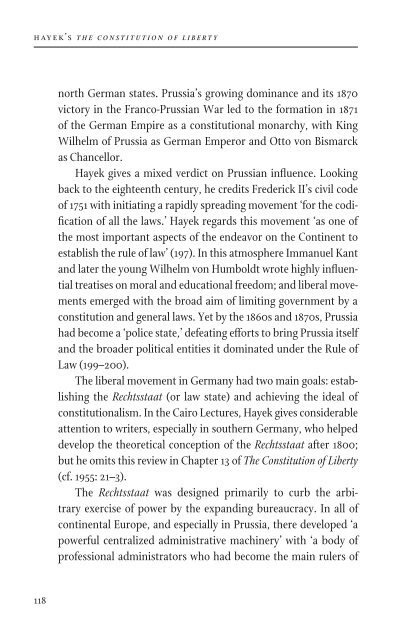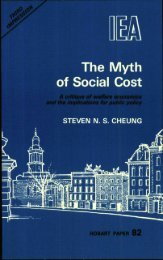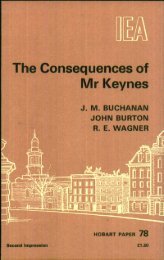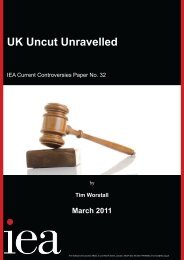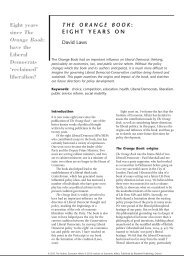Hayek's The Constitution of Liberty - Institute of Economic Affairs
Hayek's The Constitution of Liberty - Institute of Economic Affairs
Hayek's The Constitution of Liberty - Institute of Economic Affairs
Create successful ePaper yourself
Turn your PDF publications into a flip-book with our unique Google optimized e-Paper software.
h ay e k ’ s t h e c o n s t i t u t i o n o f l i b e r t y<br />
o r i g i n s a n d d e v e l o p m e n t o f t h e r u l e o f l aw<br />
north German states. Prussia’s growing dominance and its 1870<br />
victory in the Franco-Prussian War led to the formation in 1871<br />
<strong>of</strong> the German Empire as a constitutional monarchy, with King<br />
Wilhelm <strong>of</strong> Prussia as German Emperor and Otto von Bismarck<br />
as Chancellor.<br />
Hayek gives a mixed verdict on Prussian influence. Looking<br />
back to the eighteenth century, he credits Frederick II’s civil code<br />
<strong>of</strong> 1751 with initiating a rapidly spreading movement ‘for the codification<br />
<strong>of</strong> all the laws.’ Hayek regards this movement ‘as one <strong>of</strong><br />
the most important aspects <strong>of</strong> the endeavor on the Continent to<br />
establish the rule <strong>of</strong> law’ (197). In this atmosphere Immanuel Kant<br />
and later the young Wilhelm von Humboldt wrote highly influential<br />
treatises on moral and educational freedom; and liberal movements<br />
emerged with the broad aim <strong>of</strong> limiting government by a<br />
constitution and general laws. Yet by the 1860s and 1870s, Prussia<br />
had become a ‘police state,’ defeating efforts to bring Prussia itself<br />
and the broader political entities it dominated under the Rule <strong>of</strong><br />
Law (199–200).<br />
<strong>The</strong> liberal movement in Germany had two main goals: establishing<br />
the Rechtsstaat (or law state) and achieving the ideal <strong>of</strong><br />
constitutionalism. In the Cairo Lectures, Hayek gives considerable<br />
attention to writers, especially in southern Germany, who helped<br />
develop the theoretical conception <strong>of</strong> the Rechtsstaat after 1800;<br />
but he omits this review in Chapter 13 <strong>of</strong> <strong>The</strong> <strong>Constitution</strong> <strong>of</strong> <strong>Liberty</strong><br />
(cf. 1955: 21–3).<br />
<strong>The</strong> Rechtsstaat was designed primarily to curb the arbitrary<br />
exercise <strong>of</strong> power by the expanding bureaucracy. In all <strong>of</strong><br />
con tinental Europe, and especially in Prussia, there developed ‘a<br />
powerful centralized administrative machinery’ with ‘a body <strong>of</strong><br />
pr<strong>of</strong>essional administrators who had become the main rulers <strong>of</strong><br />
the people’ (193). Initially liberals saw their choice as one between<br />
either depending on the ordinary courts to decide whether administrative<br />
acts were lawful and consistent with private rights or,<br />
in line with French practice, establishing ‘quasi-judicial bodies<br />
inside the administrative machinery’ to decide on the lawfulness<br />
<strong>of</strong> administrative acts (196, 199–201). For a long time the liberal<br />
supporters <strong>of</strong> the Rechtsstaat advocated the first approach, which<br />
would depend on the ordinary courts to limit the administration.<br />
This approach came to be known as ‘justicialism.’ By the 1860s<br />
liberals had turned to a different conception, which in effect<br />
modified the first approach so as to avoid placing judicial responsibility<br />
inside the administration.<br />
Rudolf von Gneist was the main architect <strong>of</strong> the new system.<br />
Von Gneist and his supporters called for the creation <strong>of</strong> a<br />
separate system <strong>of</strong> courts, alongside the regular ones, to hear<br />
cases involving administrative actions. <strong>The</strong>se ‘were meant to be<br />
completely independent courts,’ not judicial bodies inside the<br />
administrative apparatus; and it was hoped that they would,<br />
in the course <strong>of</strong> time, ‘assume a strictly judicial control over all<br />
administrative action.’ To defend these special courts, advocates<br />
reasoned that ‘the ordinary judge, trained mainly in private<br />
or criminal law,’ cannot be expected to possess the specialised<br />
knowledge required to settle disputes over administrative actions.<br />
This argument won over liberal supporters <strong>of</strong> the Rule <strong>of</strong> Law.<br />
<strong>The</strong>reafter the Rechtsstaat came to mean a system <strong>of</strong> independent<br />
administrative courts rather than a reliance on the ordinary<br />
courts. Indeed, this new approach was seen as the Rechtsstaat’s<br />
crowning achievement. Most German administrative lawyers<br />
backed it; and a system along these lines was introduced in the<br />
German states in the 1860s and 1870s (200–202).<br />
118<br />
119


